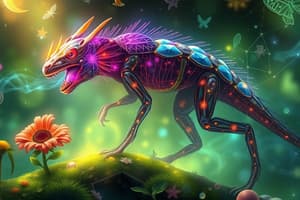Podcast
Questions and Answers
What is the broadest group in classification?
What is the broadest group in classification?
- Kingdom (correct)
- Phylum
- Genus
- Species
What level of classification is Phylum?
What level of classification is Phylum?
2nd level
What is the 7th level of classification?
What is the 7th level of classification?
Species
What is the 6th level of classification?
What is the 6th level of classification?
What defines organisms within the Species level?
What defines organisms within the Species level?
List the 7 levels in order from most broad to most specific.
List the 7 levels in order from most broad to most specific.
How is the scientific name always written?
How is the scientific name always written?
The animal group is divided into _______ __________.
The animal group is divided into _______ __________.
Animals are either ___________ or _____________.
Animals are either ___________ or _____________.
Plants are either ___________ or _____________.
Plants are either ___________ or _____________.
Organisms are divided into the kingdom based on their ability to 1)________________________ or their 2)___________________.
Organisms are divided into the kingdom based on their ability to 1)________________________ or their 2)___________________.
What is the 3rd level of classification?
What is the 3rd level of classification?
What is the 4th level of classification?
What is the 4th level of classification?
What is the 5th level of classification?
What is the 5th level of classification?
What is the largest group of the Kingdom?
What is the largest group of the Kingdom?
What is the 2nd largest group of the kingdom?
What is the 2nd largest group of the kingdom?
What is Fungi known as in the kingdom?
What is Fungi known as in the kingdom?
What is the smallest group of the kingdom?
What is the smallest group of the kingdom?
What group is known as 'bacteria' in the kingdom?
What group is known as 'bacteria' in the kingdom?
What is a prokaryotic organism?
What is a prokaryotic organism?
What is an autotroph?
What is an autotroph?
What is a heterotroph?
What is a heterotroph?
Study Notes
Levels of Classification
- Consists of seven hierarchical categories: Kingdom, Phylum, Class, Order, Family, Genus, Species.
- Progresses from broadest (Kingdom) to most specific (Species).
Kingdom
- Broadest classification group, encompassing five main categories: Animals, Plants, Fungi, Protists, and Monerans.
- Animals are the largest kingdom, composed of multi-celled, eukaryotic organisms.
- Plants constitute the second largest kingdom, also multi-celled and eukaryotic.
- Fungi includes decomposers like yeast, molds, and mushrooms.
- Protists are the smallest group, characterized as single-celled and eukaryotic.
- Monerans consist of bacteria, single-celled and prokaryotic organisms.
Scientific Nomenclature
- Scientific names follow a specific format: Genus name is capitalized, Species name is in all lower case, both italicized.
- Genus represents the 6th level of classification, while Species denotes the 7th and final level.
- Species is defined by the organisms' ability to breed and produce fertile offspring.
Classification Hierarchy
- 7 levels in order: Kingdom, Phylum, Class, Order, Family, Genus, Species.
- Each subsequent level becomes more specific in categorizing organisms.
Types of Organisms
- Organisms are classified based on:
- Ability to produce food: Autotrophs make their own food (e.g., plants, some protists).
- Cellular structure: Heterotrophs must consume food (e.g., animals, fungi, some protists).
Phyla and Types of Animals and Plants
- Animal kingdom divided into 35 phyla.
- Animals categorized as vertebrates (with backbone) or invertebrates (without backbone).
- Plants categorized as vascular (with vascular tissue for transport) or non-vascular (lacking such tissue).
Cell Structure
- Prokaryotic organisms (e.g., Monerans) lack a nucleus, distinguishing them from eukaryotic organisms (e.g., Animals, Plants, Fungi, Protists) which have a defined nucleus.
Studying That Suits You
Use AI to generate personalized quizzes and flashcards to suit your learning preferences.
Description
Explore the key terms and definitions related to the seven levels of biological classification. This quiz covers fundamental concepts such as Kingdom, Phylum, Genus, and Species, which are essential for understanding taxonomy. Perfect for students studying biology or anyone interested in the classification of life.




